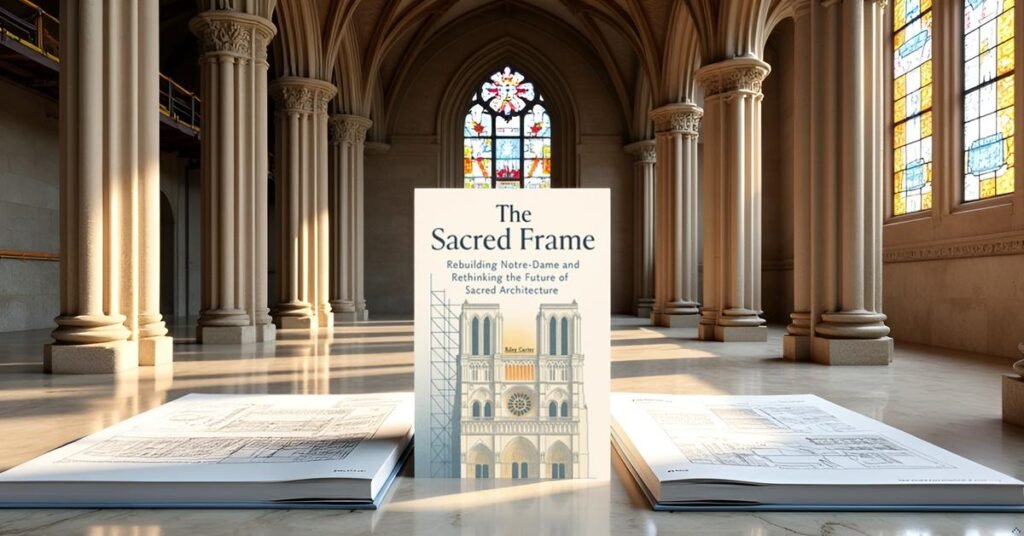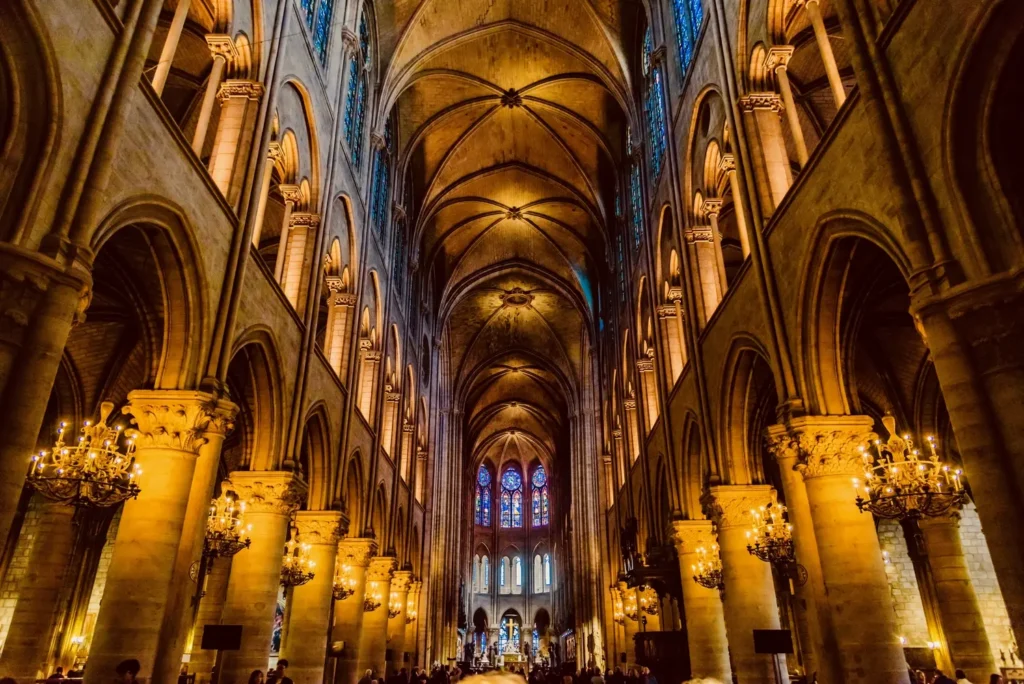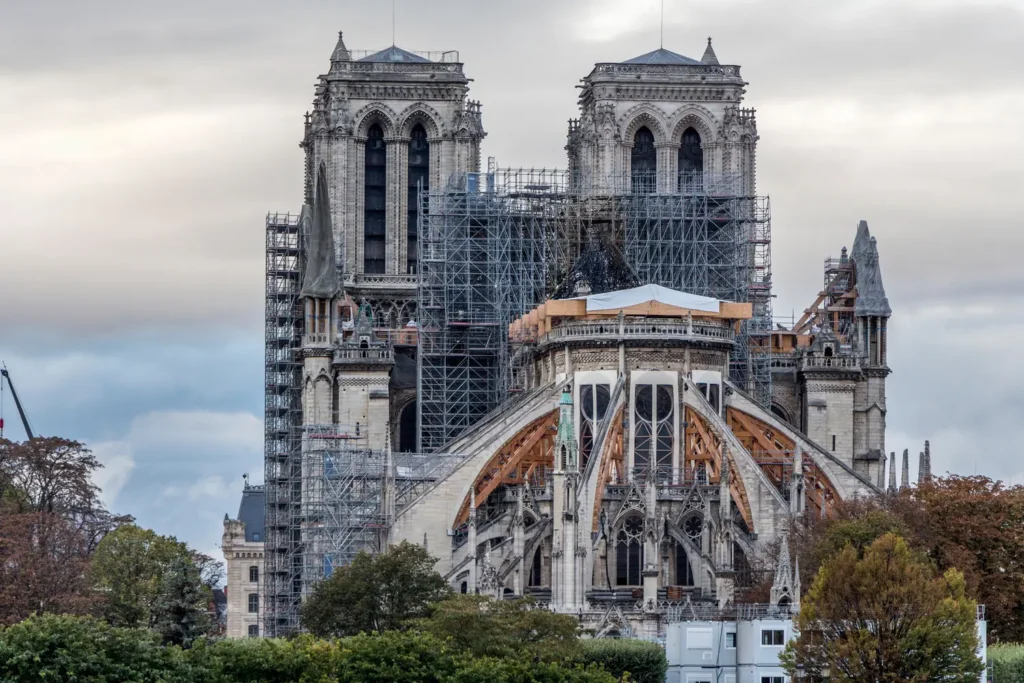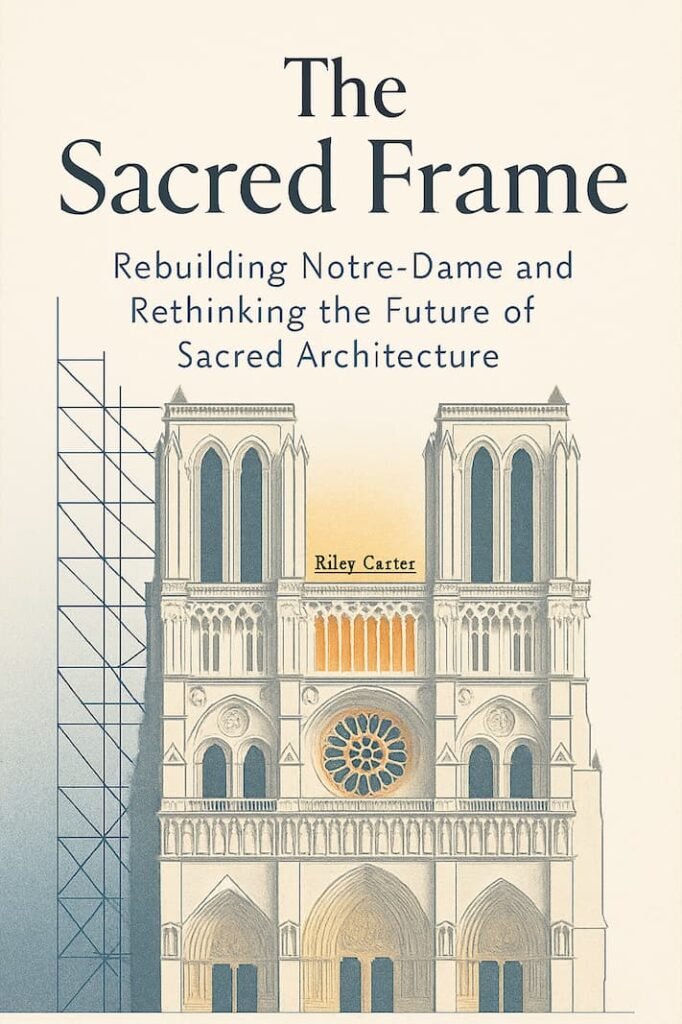
Architecture Beyond Fire and Tim?
A cathedral burns—and the world watches. But what happens after the flames die down? What does it mean to restore not just a structure, but a symbol? The Sacred Frame confronts these questions with urgency and grace, offering a powerful meditation on the meaning of sacred space in a fractured world.
More than a chronicle of Notre-Dame’s reconstruction, this book is a call to reimagine the role of sacred architecture today. From the flying buttresses of Gothic engineering to 3D scans and fire diagnostics, The Sacred Frame bridges past and future—fusing the precision of technical inquiry with the depth of architectural ethics.
Architecture as Continuity, Not Nostalgia
In The Sacred Frame, I argue that preservation is not about embalming the past—it’s about stewarding continuity through thoughtful change. Notre-Dame de Paris is not a museum artifact frozen in the 13th century; it is a layered, living structure that has absorbed and adapted to centuries of ideologies, technologies, and crises. To rebuild Notre-Dame after the 2019 fire is not to revert to a lost origin, but to extend a tradition—one that is architectural, cultural, and profoundly human.
Notre-Dame as Living Structure
Every phase of Notre-Dame’s life has been a negotiation between reverence and reinvention. The medieval builders gave it ribbed vaults and flying buttresses that defined the early Gothic idiom. In the 19th century, Eugène Viollet-le-Duc reimagined its spire and reasserted Gothic values in the language of Romantic nationalism. Now, in the 21st century, we inherit not just their forms, but their mindset: that architecture must evolve to remain meaningful.
This book explores Notre-Dame not as a single monument, but as a palimpsest—written and rewritten by each generation. Its stones carry the memory of revolutions and coronations, of desecration and renewal. The fire that damaged it did not end its life; it reminded us of its ongoing vitality. In embracing continuity over replication, we allow history to breathe. The challenge is not to mimic the past, but to interpret it with integrity.
Craft as Cultural Memory
What makes Notre-Dame remarkable is not only its form but the method by which it was made. Medieval construction was a slow, communal effort—guided by master builders and executed through guilds and apprenticeships. These crafts—stone carving, timber framing, stained-glass making—were not ancillary to the architecture; they were its DNA. And after the fire, these traditions were not romanticized—they were reactivated.
In the book, I document how present-day artisans are reviving ancient techniques: sourcing Lutetian limestone from reopened quarries, seasoning oak from sustainably managed forests, and shaping beams with tools that echo the past. This is not resistance to innovation—it is a re-centering of wisdom that has always been low-tech, high-performance, and ecologically sane.
Continuity, here, is not about style. It’s about ethic. We preserve not to idealize, but to participate in a lineage. To build with care, to pass on skill, and to keep meaning alive in the built environment.

The Emotional and Civic Power of Sacred Spaces
Notre-Dame is not only a sacred site—it is a shared emotional landscape. From spontaneous vigils in the wake of the 2019 fire to the silent awe of tourists beneath its ribbed vaults, the cathedral functions as a space of universal affect. In The Sacred Frame, I explore how sacred architecture transcends doctrine to touch something deeper: our collective yearning for stillness, connection, and beauty.
A Secular Pilgrimage
We live in an era where religious participation is declining in many parts of the world, but the desire for transcendent experience remains. Notre-Dame is a place where the sacred persists, even for the secular. You don’t have to be Catholic—or religious at all—to feel the weight of the columns, the hush of filtered light through stained glass, or the gentle rise of incense from the altar. These are not accidents of form; they are spatial cues to reverence.
When I walk through the nave, I see people from every background—some praying, others quietly weeping, others just looking up, phones lowered, caught in a rare moment of unmediated awe. That choreography of attention is a kind of liturgy in itself. The architecture invites reflection, whether spiritual or simply human.
This is what I call a secular pilgrimage: a journey not toward conversion, but toward stillness. Notre-Dame teaches us that architecture can hold meaning across boundaries. It offers room for memory, wonder, and presence—no translation required.
Beauty as Public Resource
One of the most powerful ideas I advocate in the book is that beauty is not a luxury—it’s a civic right. Notre-Dame’s grandeur is freely accessible. Its facades, carvings, and vaults don’t require a ticket or a degree to be appreciated. In a world increasingly defined by gated spaces and monetized experiences, this matters.
The cathedral stands in quiet defiance of architectural elitism. It is shared splendor. Its aesthetic generosity—its ability to move, to teach, to comfort—is part of its function. Gothic builders understood that beauty could be a tool of moral and emotional education. Rose windows weren’t just decorative; they were luminous lessons, casting biblical stories in chromatic light. Sculptures taught the illiterate. Ornament was pedagogy.
In this sense, the cathedral is not just a building; it’s a form of public care. When we restore beauty, we’re not indulging in nostalgia. We’re affirming that joy, dignity, and reflection have a place in civic life. Notre-Dame is a reminder that architecture can uplift without exclusion—and that such spaces are worth preserving not just for what they are, but for what they give.
Preservation as Ethical Practice
After Notre-Dame’s spire collapsed in flame, the global conversation shifted almost instantly: not just how to rebuild, but how to do so ethically. In The Sacred Frame, I explore preservation not as a set of technical constraints, but as a moral framework—one that asks architects, governments, and the public to weigh memory against modernity, fidelity against responsibility.
Rebuilding with Intention
There is a fundamental difference between reconstruction and rebuilding. One seeks replication; the other, continuity. When the French government announced plans to rebuild the spire “as it was,” using original materials and carpentry methods, some viewed it as a retreat into nostalgia. I see it differently. It was a declaration: that memory is not static, but active—and that honoring a form does not preclude updating its context.
In the book, I examine how this rebuilding process became an ethic in action. Engineers modeled vault stress under thermal shock. Historians consulted hand-drawn details from 19th-century archives. Carpenters trained in medieval joinery. These acts are not just about fidelity—they are about care. Rebuilding Notre-Dame was never about aesthetic purity. It was about restoring a relationship: between people and their past, between craftsmanship and civic identity.
To rebuild is to choose what we value—and why it’s worth protecting.
Stewardship Beyond Ownership
Notre-Dame does not “belong” to a single institution. It is managed by the French state, used by the Catholic Church, and beloved by millions worldwide. In this complexity lies a deeper lesson: great architecture is not a possession; it’s a trust. And stewardship, unlike ownership, is defined by responsibility, not rights.
Preservation demands we think in long timelines. The builders who first laid stone at Notre-Dame knew they would never see it completed. Their investment was intergenerational. Today, our responsibility is not only to keep the building standing, but to keep its meaning alive. That means adapting it intelligently to climate goals, accessibility, and public engagement—without erasing its spirit.
Ethical preservation doesn’t freeze a building in time. It lets it evolve, in dialogue with the society that sustains it.
This section also explores preservation as a democratic act. In the wake of the fire, design competitions, public forums, and citizen commentary became part of the process. Notre-Dame’s future wasn’t decided behind closed doors—it was shaped through collective voice. That’s what makes it a model: not only of resilience, but of transparency.

Sacred Design for a Plural Future
In a world increasingly defined by diversity—of culture, faith, and worldview—the meaning of sacred space must evolve. The Sacred Frame invites architects and preservationists to reconsider what it means to design for the sacred in societies where belief is no longer homogenous, and where ecological urgency redefines permanence. Notre-Dame offers a powerful case study, not only for what it has been, but for what it can become.
Rethinking Sacredness
Notre-Dame was built to house Christian worship. But today, its impact transcends theology. For many, it represents continuity, craftsmanship, and wonder—not just doctrine. In that widening resonance lies an opportunity: to design sacred space as a civic asset, not just a confessional one.
In the book, I reflect on how Notre-Dame’s atmosphere—its interplay of light and shadow, its acoustics, its spatial rhythm—cultivates reverence without demanding belief. This is sacredness as experience, not prescription. We can design with that in mind. We can create places that center reflection, welcome diversity, and invite stillness in a noisy world.
Sacred architecture today must serve more than ritual; it must serve community. That means making room for the plural, the secular, the questioning. It means recognizing that silence, beauty, and emotional resonance are forms of spiritual accessibility.
Heritage as Ecological Wisdom
Notre-Dame also challenges us to see heritage not as carbon-heavy indulgence, but as ecological practice. Gothic cathedrals were among the original climate-responsive buildings—thick stone walls for thermal inertia, narrow windows for solar control, and passive ventilation centuries before the term existed.
In rebuilding, this tradition has continued. The decision to reuse limestone, to handcraft timber, to avoid synthetic materials where possible—these weren’t only cultural gestures. They were ecological strategies. Preserving historic buildings, when done thoughtfully, reduces demolition waste, avoids new embodied carbon, and conserves the knowledge embedded in low-tech, high-performance construction.
Sustainability isn’t always about innovation. Sometimes, it’s about remembering.
I believe that the future of sacred architecture lies in this intersection: where meaning meets material ethics, where tradition becomes a roadmap, and where design is not about aesthetic control but ecological humility. Notre-Dame, in its rebirth, shows us that sacred space can still teach, even when its theology evolves. It reminds us that beauty, patience, and repair are themselves acts of stewardship—toward each other and the planet.

Hope as a Design Ethic
Rebuilding Notre-Dame after the 2019 fire was never just a technical project. It was, and remains, an act of cultural hope. In The Sacred Frame, I describe hope not as sentimentality, but as discipline—a design ethic that holds space for continuity even amid fracture. To rebuild is to affirm that some things—memory, craft, meaning—are too important to abandon.
Rebuilding as a Cultural Gesture
In the days after the fire, I watched as millions mourned. But I also witnessed something deeper: a refusal to let Notre-Dame’s story end in smoke. That refusal became a shared design brief. It wasn’t simply about restoring a silhouette or salvaging materials. It was about preserving meaning—and transmitting it forward.
Hope, in architectural terms, is choosing to rebuild when it would be easier to move on. It’s training new artisans in old methods. It’s debating how to balance fidelity and innovation without cynicism. It’s restoring not because we must, but because we believe that legacy matters.
That belief is what the spire now represents. Not a return to the past, but a recognition of the present’s responsibility to the future.
Crafting Continuity Across Generations
One of the most powerful aspects of Notre-Dame’s restoration has been its global pedagogy. Carpenters trained in medieval joinery. Engineers tested vaults for thermal resilience. Historians mapped damage with digital scans. In every corner of the project, there is transmission—of knowledge, of values, of care.
This is what I mean by hope as design ethic: a commitment to learning from rupture rather than erasing it. The fire becomes part of the cathedral’s biography—not its end, but its hinge.
Architecture is often thought of as the art of permanence. But in truth, it’s the art of continuity. Of building with the awareness that structures—like civilizations—must be able to endure change. Notre-Dame’s restoration does not deny its trauma; it carries it forward, visibly and meaningfully.
And that, to me, is the essence of hopeful design: not blind optimism, but a steady willingness to repair. To invest in what connects us, to protect what uplifts us, and to honor what we inherit—not for ourselves, but for those who will come next.
Dr. Riley Carter
Architect | Educator | Passive House Advocate
